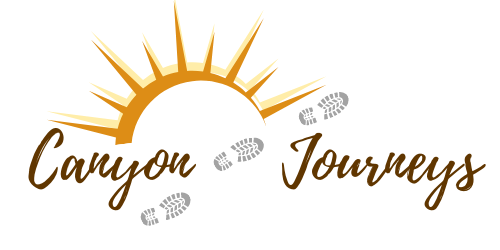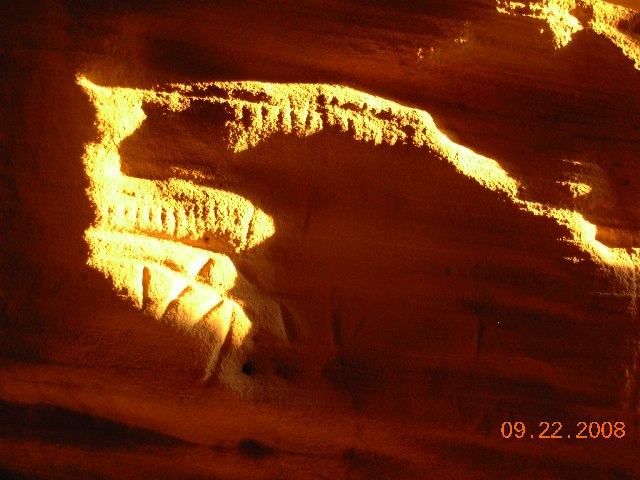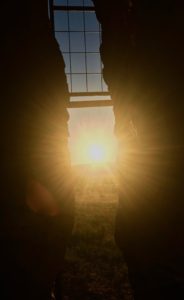
In a remote corner of Colorado, several miles and multiple cattle guards off the
More a crevice than a cave, Crack Cave splits the sandstone wall behind the ruins of a homestead on the east side of Picture Canyon. The crack extends back approximately 20-25 feet. Even by turning sideways, it is barely wide enough for a person to
How It All Began
As I understand it, in 1982* a group from the Western Epigraphic Society were doing an exploratory expedition and were in Picture Canyon. Dan Roher, the then society treasurer, entered the cave and reported “Ogam-like markings on the walls.” At the time no one had a working photo flash on their camera, and the site was filed away for future investigation. (McGlone, Leonard, Ancient Celtic America)
Fast forward a couple of years to June 22, 1984 when a PBS documentary, “History on the Rocks,” was being filmed by Scott Monohan. During the filming, Crack Cave was visited by Bill McGlone and Phil Leonard just to see if something new might be found on camera. The result was Phil Leonard giving his
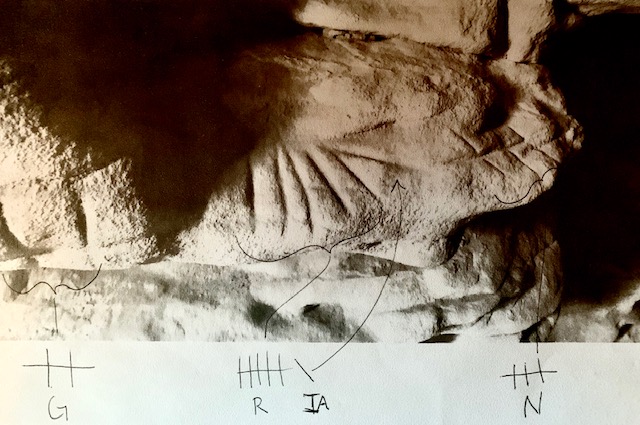
Further examination of the crevice in the canyon wall showed that the orientation of the crack faced east, possibly indicating a solar (sun) alignment site during the equinox. Since the orientation was to the east, it would additionally indicate a possible sunrise alignment. This being June, the group decided to return in the fall for the equinox.
The group returned in September of 1984 to film the sunrise in Crack Cave and confirm their theory that the site was a sunrise equinox alignment site. Since that time, the site has been accepted as an equinox alignment site by most researchers. Crack Cave has since been visited by hundreds of people to view the solar alignment that happens at sunrise on equinox morning both fall and spring.
Shows Equinox Alignment at Crack Cave
What Happens on the Morning of Equinox?
On the north wall of Crack Cave is a petroglyph that resembles some random markings with two horizontal lines of closely incised vertical lines. At the moment of sunrise the sun strikes the rock in such a way as to outline the petroglyph. This specific alignment of the sun on the rock only happens on the day of equinox, and is significantly altered on days before and after the equinox, with the sunlight not even falling into the cave at sunrise until within several days both before and after the day of equinox. The narrow opening of the cave makes the sun’s rays penetration of the crack very specific to the time of year in which the sun is at it’s most easterly alignment along the horizon.
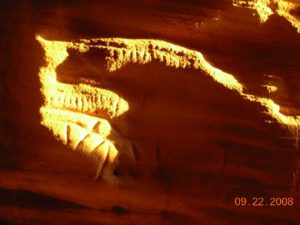
on Glyph in Crack Cave
The whole glyph appears to at one time have been framed by an incised line that is very faint and easily overlooked. This glyph is considered to be an Ogam inscription by some, as well as pictoral. The way it was inscribed on the cave wall seems to represent the curved sun and its rays. The bottom part of the glyph is argued to be an Ogam inscription that says, ” the sun strikes here on the day of Bel.” Bel is thought to refer to the Celtic Sun God, Belenus.
” The SUN STRIKES HERE ON THE DAY OF BEL”
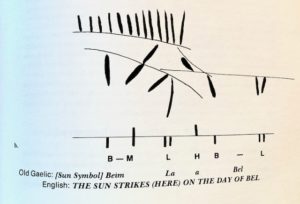
The whole event is relatively short since the earth’s rotation is constantly on the move and the sun moves across the glyph, distorting the initial alignment within a few
The Controversy of Crack Cave
“The controversy at Crack Cave is not about the suggested connection between the rayed petroglyph and the sun’s penetration of the cave at sunrise on each equinox. Rather, the debate concerns whether the incised lines represent an Ogam inscription that foretells such events.”
Lawerence Loendorf
Mr. Loendorf goes on in his book, ‘Thunder and Herds; Rock Art of the High Plains,’ to state that, “It is well known that the solstices and equinoxes were important to the Plains Indian tribes who used geologic features as rock art calendars.” There are many Native American sites in North America to back up this statement. Such sites include the council circles in Kansas, medicine wheels in Wyoming, the orientation of the mounds at Spiro, OK, and petroglyphs and alignment of buildings and roads at Chaco Canyon, not to mention sites created by the ancient cultures of South America including the Mayans, Aztecs, Incas, etc.
Mr. Loendorf’s argument is, “Considering this tradition (of Native American calendar sites), one has to wonder why the search for alternative explanations of features used by First Americans for astronomical computation has gained such momentum. I think one reason is related to the cultural bias. People simply have difficulty accepting that the American Indian cultures were sophisticated enough to appreciate what the solstices represent.” Loendorf cites the public debate that occurred when the solar alignment petroglyph calendar at Fajada Butte in Chaco Canyon was discovered. Some thought the site was naturally occurring, others believed it was an intentional design. It took time and research for the site to be deemed authentic.
Loendorf has a valid point, when any new idea or skill is “discovered” or “re-discovered” through archaeological means, there is always debate. Why? Frankly, due to the fact that all historical research with no written records, such as is often the case in North America, is based on educated deductions garnered from research. We can only make the best guess with the information we have. Every conclusion will be flavored with the experience and opinion of the researcher.
Isolationism or Diffusionism
Ultimately the debate comes down to isolationism or diffusionism.
Diffusionism, as an anthropological school of thought, was an attempt to understand the distribution of culture in terms of the origin of culture traits and their spread from one society to another. Versions of diffusionist thought included the conviction that all cultures originated from one culture center (heliocentric diffusion); the more reasonable view that cultures originated from a limited number of culture centers (culture circles); and finally the notion that each society is influenced by others but that the process of diffusion is both contingent and arbitrary (Winthrop 1991:83-84). (University of Alabama, Department of Anthropology)
Social Evolutionism or Isolationism, innovation in a culture, was considered to be continuous or at least triggered by variables that are relatively exogenous. This set the foundation for the idea that many inventions occurred independently of each other and that diffusion had relatively little effect on cultural development (Hugill 1996:343). ((University of Alabama, Department of Anthropology)
In not so technical terms, cultures either influenced each other through history (diffusinoism) or they didn’t. Social evolution says they evolved on their own with no outside influence. Basically, if they had an idea, they came up with it on their own. With social evolution, each culture would have “re-invented the wheel” for every similar idea, often due to their geographical isolation. The debate about which is the best theory is very intense, to the point where social evolutionists sometimes infer that diffusionists believe that people who learn from other cultures may not be smart enough to have thought of it on their own (such as Loendorf infers). An interesting train of thought.
In terms of Picture Canyon and Crack Cave, the debate presented by researchers such as Bill McGlone and Phil Leonard encourage thoughts of diffusionism and the idea that people from the “Old World” or Ireland, Spain and Northern Africa, probably visited our continent much earlier than is currently accepted. They traveled by boats and walked up waterways to visit vast areas of North America. In doing so, they may have influenced native cultures to a certain extent as they came and went. They argue that artifacts such as coins, small figurines, pendants, and petroglyphs confirm their presence.
Traditional views of Crack Cave place it in the category of a Native American calendar site, which confirms the date of equinox during the year. With the vast evidence of other such Native American sites, it is not unique in its ability to tell the date of equionx. The site is part of an area known to have been regularly used by Native Americans over a long period of time. It is an interesting site, but with no need to interpret it in any other way than through the conventional archaeological interpretation.
Loendorf puts it this way, “Occam’s Razor is a time tested rule in research that can be summarized as favoring the least complicated of two or more explanations for a phenomenon, other things being equal. In the case of the petroglyph and incised marks at Crack Cave, their explanation does not require a complex hypothesis involving inscriptions made by ancient Celtic visitors, because a well-documented tradition of aboriginal astronomical observation already exists.” Loendorf says it fits nicely within the historically accepted and researched setting in which it is placed, why look any further?
Who is correct? Honestly, I don’t believe anyone can say definitively who is correct and who is not because they weren’t there! The only conclusions that either side can make are educated guesses based on their experience, background, and knowledge. Both sides in this matter have interesting and intriguing arguments. For me, the “mystery” about Crack Cave is half the fun.
Join us for an equinox tour and make your own conclusion! Attendance is limited and reservations are required.
*Guessing from dates recorded in Ancient Celtic America and Archaeoastronomy of Southeast Colorado and the Oklahoma Panhandle. The specific year of the first visit where Ogam was thought to be recognized is not stated.
References
Gail King, Meghan Wright and Michael Goldstein, Diffusionism and Acculturation, University of Alabama, Department of Anthropology, https://anthropology.ua.edu/theory/diffusionism-and-acculturation/
Lawrence L Loendorf, Thunder & Herds; Rock Art of the High Plains, pg 206-207., C. 2008
Anna Sofaer , Chaco Astronomy; An Ancient American Cosmology, pg 15, C. 2014
McGlone, Leonard, Ancient Celtic America, pg 146-156, C. 1986
McGlone, Leonard, Barker, Archaeoastronomy of Southeast Colorado and the Oklahoma Panhandle, pg. 50-53, C.1999
All Photographs are my own.
